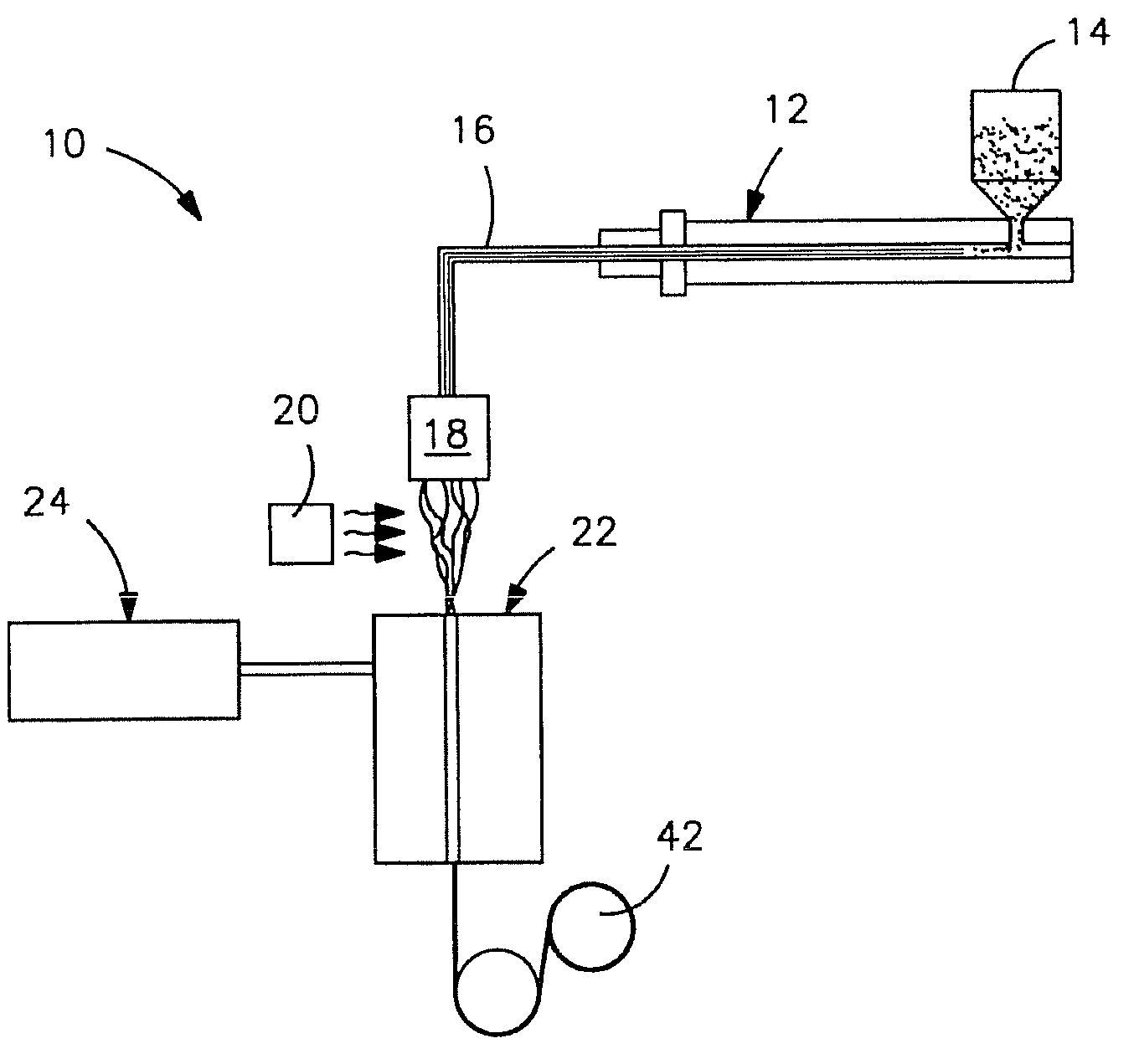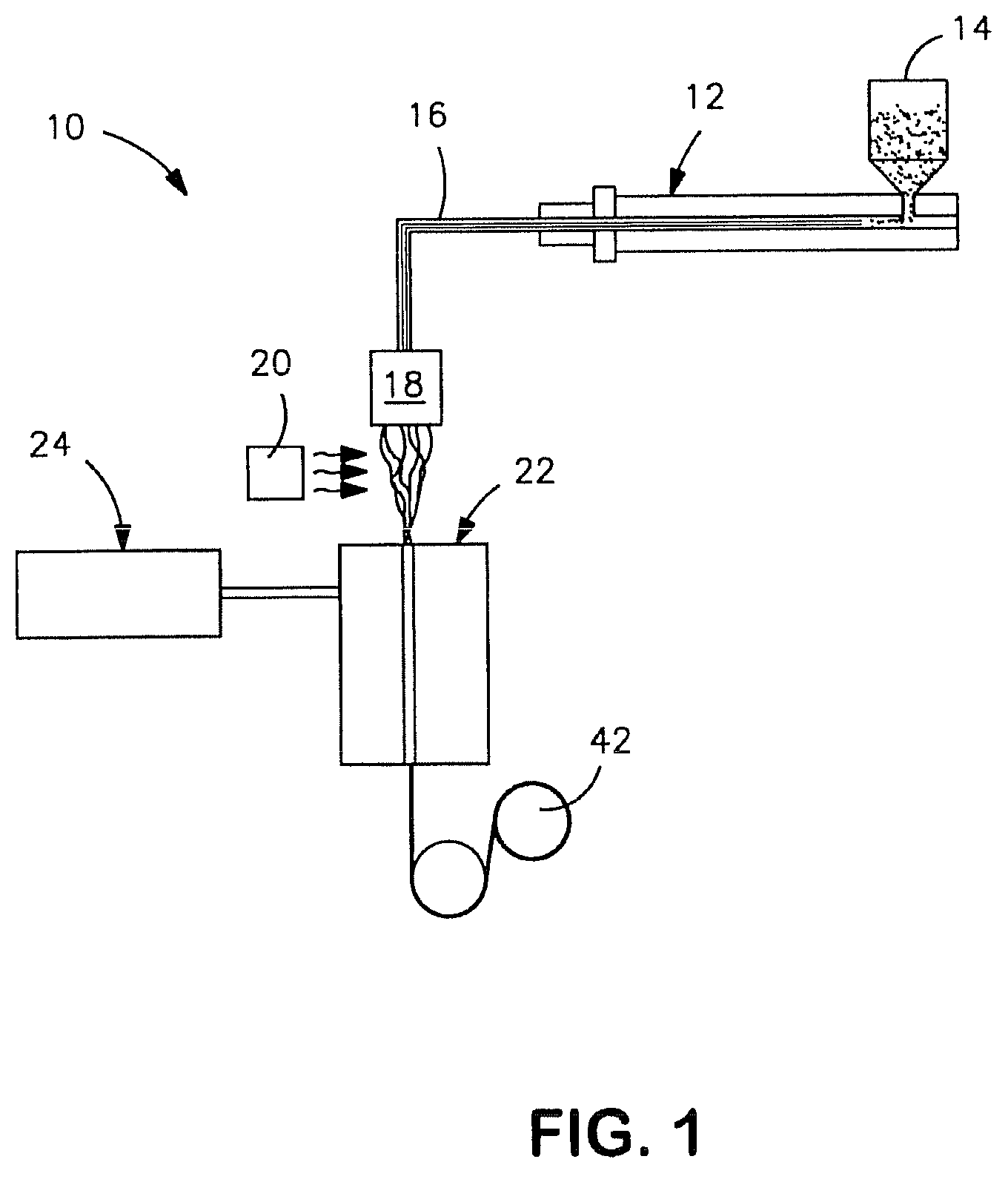Polylactic acid fibers
- Summary
- Abstract
- Description
- Claims
- Application Information
AI Technical Summary
Problems solved by technology
Method used
Image
Examples
example 1
[0094]Three blends were formed from polylactic acid (PLA 6202, Natureworks), maleic anhydride-modified polypropylene copolymer (Fusabond® MD-353D, Du Pont), and polyethylene glycol (Carbowax® PEG-3350, Dow Chemicals). More specifically, a co-rotating, twin-screw extruder was employed (ZSK-30, diameter) to form the blend that was manufactured by Werner and Pfleiderer Corporation of Ramsey, N.J. The screw length was 1328 millimeters. The extruder had 14 barrels, numbered consecutively 1-14 from the feed hopper to the die. The first barrel (#1) received the PLA resin, PEG-3350 powder and Fusabond® 353D resin via 3 separate gravimetric feeders at a total throughput of 18 to 21 pounds per hour. The temperature profile of the barrels was 80° C., 150° C., 175° C., 175° C., 175° C., 150° C., 150° C., respectively. The screw speed was 180 revolutions per minute (“rpm”). The die used to extrude the resin had 2 die openings (6 millimeters in diameter) that were separated by 4 millimeters. Upon...
example 2
[0096]The compounded samples of Example 1 (Samples 1-9) were fed into a single heated spin pack assembly to form filaments. The filaments exiting the spinneret were quenched via forced air ranging from ambient temperature to 120° C. and a linear draw force was applied using a godet at speeds up to 3000 meters per minute. Blends were processed at a throughput of 0.23 gram per hole per minute through a 16 hole die. The fiber spinning conditions are set forth below in Table 3.
TABLE 3Melt Temp.Pack PressureExtruder ControlMelt PumpExtruder ScrewHeated QuenchGodet SpeedDrawSample(° C.)(psi)Pressure (psi)Speed (rpm)Speed (rpm)Air(m / min)RatioPLA Control24022560054Yes275042611240135500554Yes300046482240175500550Yes300038733240185500532Yes300046484240105490558Yes250038735215170500530Yes140021696240230500537Yes30004648724095500568Yes140021698240100500568Yes220034089240155500544Yes30004648
[0097]Fibers were then tested for tenacity and elongation as described above. The results are set forth be...
example 3
[0100]Various concentrates were formed by pre-melt blending polylactic acid (PLA 6201, Natureworks), maleic anhydride-modified polypropylene copolymer (Fusabond® MD-353D, Du Pont), and polyethylene glycol (Carbowax® PEG-3350, Dow Chemicals) and then dry blending with virgin polylactic acid (PLA 6202, Natureworks) as described in Example 1. Table 6 shows the blends run during the trial and the basis weight of the webs produced.
TABLE 6FusabondBasisPLA 6201PLA 6202MD-353DPEG 3350WeightCode(wt. %)(wt. %)(wt. %)(wt. %)(gsm)PP Control100% polypropylene (PP 3155, ExxonMobil)17108013.42.24.417118013.42.24.422127020.13.36.622137020.13.36.617
[0101]Each of the samples was processed using the same extrusion temperature profile of 200° C., 215° C., 215° C., 215° C., 215° C., and 215° C. The melt blend went from the extruder to a melt pump turning at 15.9 rpm that resulted in a throughput of 0.65 grams per hole per minute on the 64 hole per inch spinpack. The melt was extruded through the spinpac...
PUM
| Property | Measurement | Unit |
|---|---|---|
| Temperature | aaaaa | aaaaa |
| Temperature | aaaaa | aaaaa |
| Temperature | aaaaa | aaaaa |
Abstract
Description
Claims
Application Information
 Login to View More
Login to View More - R&D
- Intellectual Property
- Life Sciences
- Materials
- Tech Scout
- Unparalleled Data Quality
- Higher Quality Content
- 60% Fewer Hallucinations
Browse by: Latest US Patents, China's latest patents, Technical Efficacy Thesaurus, Application Domain, Technology Topic, Popular Technical Reports.
© 2025 PatSnap. All rights reserved.Legal|Privacy policy|Modern Slavery Act Transparency Statement|Sitemap|About US| Contact US: help@patsnap.com



